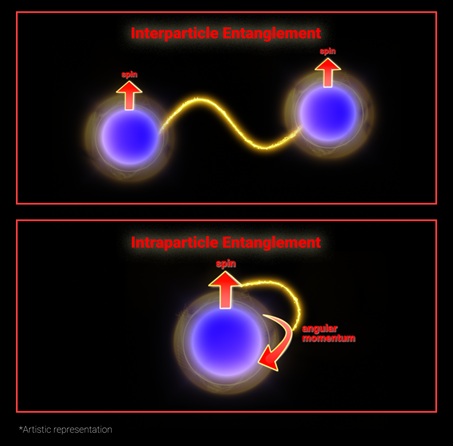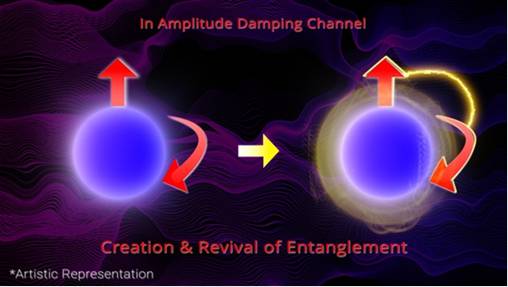Ministry of Science & Technology
Noise brings quantum surprise from Indian Scientists
प्रविष्टि तिथि:
14 JUL 2025 3:44PM by PIB Delhi
Breakthrough research reveals that quantum noise, the random disruptions so far believed to be a menace as they mess with delicate quantum systems, may not be the villain we assumed and sometimes may bring benefits on its way.
At the heart of this discovery is quantum entanglement, a strange phenomenon Einstein once called “spooky action at a distance.” It is a mysterious link that binds particles across space and lies at the heart of quantum physics. Traditionally, quantum noise is seen as the enemy of entangled systems, causing them to lose their entanglement, a phenomenon known as ‘Decoherence’.
A new study from researchers at the Raman Research Institute (RRI) and collaborators reveals that the intraparticle form of entanglement (that involves links within a single particle), a less-known cousin of quantum entanglement, is not only more robust in the face of noise, but can also emerge from noise itself.

Fig 1: Interparticle Entanglement vs Intraparticle Entanglement
With a precise mathematical formula to track how this entanglement changes under noise, Researchers at RRI, an autonomous institute of the Department of Science and Technology (DST), Government of India, along with collaborators from Indian Institute of Science, Indian Institute of Science Education and Research - Kolkata and University of Calgary, discovered that noise, specifically amplitude damping, not only erases entanglement but also revives it under certain conditions.
Even more astonishingly, it can generate entanglement in an initially unentangled state in intraparticle systems. In other words, under the right conditions, noise does not just destroy quantum correlations, but can help build them too.

Fig 2: In Intraparticle Entanglement, noise from an amplitude damping channel can not only generate entanglement, but also revive it.
When the same analysis was applied to interparticle entanglement involving two separate particles the results were dramatically different. Entanglement simply decayed, with no signs of revival or spontaneous creation. This suggests that intraparticle entanglement is more robust and resilient under environmental noise and while the revival and creation phenomena were observed specifically under amplitude damping conditions. The slower decay of intraparticle entanglement compared to interparticle entanglement was consistent across all three noise channels studied.
“To analyse this behaviour, we derive an exact analytical expression for the concurrence (a key measure of entanglement) of an intraparticle entangled state subjected to an amplitude damping channel, which also admits an elegant geometric representation” said Animesh Sinha Roy, the paper’s lead author and Post-Doc fellow at RRI. This formula makes it possible to predict exactly how entanglement will behave, depending on the input state and the strength of the noise.
The ability of intraparticle entanglement to survive and even revive under noise indicates it may be a valuable tool for constructing more efficient and stable quantum systems that may have significant implications for quantum technology. “Our study lays down the general framework for decoherence in intraparticle entanglement. As a next step, one should extend this towards specific physical systems to make this even more realistic. We ourselves are working on an experiment using single photons and intraparticle entanglement in certain quantum technology applications such as Quantum Communication and Computing.” said Professor Urbasi Sinha, head, Quantum Information and Computing (QuIC) lab at the RRI. Additionally, since the results are not dependent on any particular physical setup, they would be stable over a range of platforms such as photons, neutrons and trapped ions.
Notably, the study published in Frontiers in Quantum Science and Technology, uses the Global Noise Model, which considers the particle as a whole, unlike most previous models that treat each part of the system separately. This brings a more physically realistic scenario since the internal properties of a single particle typically interact with the same environment.
Gaining insight into how entanglement behaves under actual noisy conditions is essential for developing practical and resilient quantum resources.
The team explored the impact of three common types of quantum noise: amplitude damping, phase damping and depolarizing noise on these intraparticle systems. Each of these simulates a different kind of environmental disturbance. Amplitude damping, for instance, represents energy loss in the system, similar to how an excited quantum state relaxes to a ground state. Phase damping disrupts the delicate phase relationships critical for quantum interference, while depolarizing noise randomly alters the quantum state in all directions.
Prof. Dipankar Home, an expert in the field of Quantum entanglement from Bose Institute, Kolkata, called this work “indeed a breakthrough,” continuing, “It promises to open up uncharted avenues for user-friendly, commercially viable cutting- edge quantum technological applications in the presence of various models of noise/damping using a novel form of entanglement, viz. the entanglement between different properties of a single particle, called intraparticle entanglement.”
This study, which is under the India-Trento Programme on Advanced Research (ITPAR) and partially supported by National Quantum Mission (NQM) of DST, challenges the long-standing assumption on its head: that noise is inevitably the foe of entanglement. It reveals that under certain conditions noise can be an uncharacteristic friend. It creates new avenues for frontier research and innovation technology, implying that the quantum world remains full of hidden surprises, with many of its secrets still waiting to be uncovered.
***
NKR/PSM
(रिलीज़ आईडी: 2144514)
आगंतुक पटल : 205